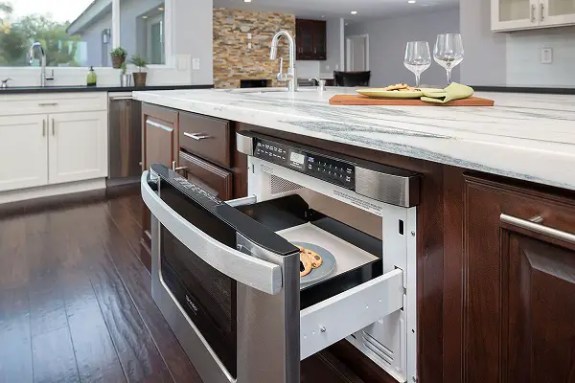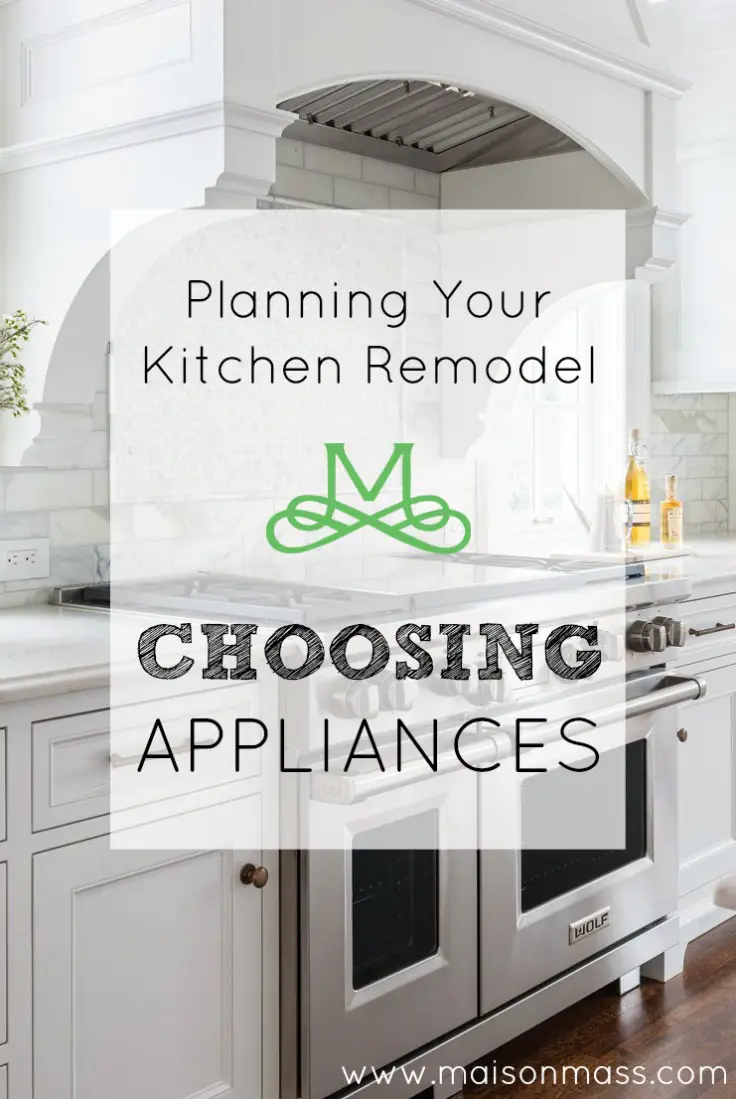There are a number of factors to consider in selecting those kitchen appliances that work best for your home and family while not busting your budget. Before window shopping, first know your budget for all your appliances. Having an overall budget and a price range for each respective appliance will help keep you on track. It’s all too easy to fall for the new, deluxe model and want, in that moment, to throw caution to the wind and the budget with it. If you decide to splurge on one or even two appliances, then you may likely have to make concessions elsewhere.
Refrigerators
We presume a certain degree of basic functionality with refrigerators: that they will keep our food cold. That efficiency is determined by the compressor. Single-compressor units that power a refrigerator-freezer work doubly hard by sending the cold air through both freezer and refrigerator compartments. A dual-compressor unit has a compressor for each of the two and thus is more cost-efficient in the long-run. It costs more initially but works more effectively – allowing you to keep your food fresh longer.

Source: kitchen remodel.com; French Door refrigerator and wall ovens
Cost
This and your stove are the two most expensive appliances in your kitchen. The basic full-size refrigerator starts around $400 and spikes to $6,000 for a smart fridge, or $8,000 for the exclusive Sub-Zero, Thermador and Jenn-Air brands. Have an idea of what you’re willing to spend here before window-shopping. Remember, that the bigger the refrigerator, the more it will cost you on the front and back end, in energy spending.
Configuration
Deciding the configuration of the refrigerator is a process in itself. The freezer placement is what informs the layout. The most popular options are the side-by-side, top freezer, lower freezer, and the french door model (a side by side with a lower freezer drawer). Don’t be fooled into thinking it’s only an aesthetic preference; there are subtle operating and sharp pricing variations among the different models.
Size
How big is big enough? That will depend on the number in your household. Generally, plan for 4-6 cubic feet per adult. Most full-size refrigerators range in size from 10-32 cubic feet. If you’re looking for a small (<20 cubic feet) refrigerator, you’ll have to consider the top or low freezer models, as they’re the only smaller dimension options. Whatever you decide, make sure to have accurate dimensions (width, height and depth of space) beforehand.

Source: kieffers.com; side-by-side counter-depth refrigerator
Counter-Depth
A regular depth refrigerator measures between 30-34 inches, whereas a counter-depth refrigerator, measures between 23-27 inches deep. The counter-depth is obviously a good size smaller. You’ll have to choose your poison; you sacrifice the more streamlined look for the larger fridge or you sacrifice the extra condiments for consistency. The choice is yours; however, be aware that even the counter-depth refrigerators will not likely be totally flush with your cabinets. To ensure there is enough clearance for the doors, the refrigerator may stick out an inch beyond your cabinets or there will need be space on either side of the refrigerator for the doors to clear. They won’t stick out nearly as far as the regular refrigerators though; these jut out significantly further into the room and away from your cabinetry. If that will aggravate you, go counter-depth. Counter-depth refrigerators are primarily offered as a side-by-side or french door model and will run a bit more than the deeper models.
Features
Features can make us as giddy as can the word sale. A feature though is only worthwhile if its useful. Consider again what you need and want from this refrigerator before window-shopping. In the moment, it all sounds good (and pearly white like the gates of heaven) but there are features that will hold appeal and some that won’t.
Energy Efficiency: Since the refrigerator claims the biggest upfront expense and the biggest energy suck, its energy rating is an important factor to consider. It’s worth spending a bit more for a high Energy Star rating.
Temperature: While prioritizing your wants, begin with your favorite foods. If consuming fresh ingredients often, you’ll be interested in sectional climate control for different compartments. Some drawers are likewise temperature-controled. If you cook and freeze in batches, the freezer should be a consideration. There are defrosting features that prevent against freezer burn. Some refrigerators even tout built-in wine racks.
Storage: Most refrigerators offer some flexibility in storage. Shelves fold up or slide under themselves, allowing room for taller items. The ice maker is not a storage solution but rather a consideration. They can steal a lot of space from your freezer with both a top-shelf ice maker and attached ice chute on the door. Some, however, squeeze the entire ice maker into the door itself. It makes less ice but saves space.

Source: GE; K-cup brewing feature
Water Dispenser: Some French door dispensers can now dole out water in pre-set volumes; some can detect when the glass or pitcher is full and stop automatically. A GE model offers an auto-fill pitcher inside the refrigerator that like a coffee pot when shelved, flicks a switch and immediately replenishes itself. More on coffee… another GE model dispenses hot water and allows for a K-cup insertion to brew your other favorite beverage.
See-Through Panel Doors: Whether this is a feature or a nightmare depends on you and your family. It’s a bit like open-shelving in my book. If you’re uber-organized and have nice dishes to display, open shelving is a plus. The same is true of see-through panels I presume. The idea is that it looks very cool, very trendy and is energy-efficient; you needn’t open the door (and release the cold air) to realize you’ve not shopped in a week.

Source: decoist; see-through-paneled door
Smart Technology: Certainly, the ultimate feature, smart technology, is only worthwhile if you’ll take advantage of all it has to offer and that is really the question. It will probably cost about an additional $1k but offers options no regular fridge can compete with. Depending on the make, there are a variety of offerings including: energy monitoring (e.g. sending a txt when there’s a power failure), interior fridge cameras to scan your fridge remotely, voice control to gauge temperatures, and most impressive – kitchen command centers providing a digital screen with access to family calendars, recipes, timers, and even music. These refrigerators are still a novelty and for the elite who want all the bells and whistles. That may not be the case for long though. Each of these outlined features above was once the latest and greatest but many have now been absorbed into more standard models.
Cooktops, Ovens, Ranges
It’s worth clarifying here the difference and/or overlap between the three. The oven is the appliance in which you bake and roast. It can be placed under a countertop or inside the wall, or it can be part of a range unit (includes cooktop). The cooktop can likewise be part of the range or it can be placed separately, built into the countertop. After the refrigerator, this is the most expensive appliance purchase. Besides that and the fact that it should last you ten some years, you’ll want to give it hearty consideration.
Configuration Considerations
This is a particularly important question for a remodel as preferences determined here can shape the entire kitchen. This is solely a matter of preference in configuration and look. Some like the look of a big stainless, statement range with cast-iron burners that informs what room you’ve entered. Some prefer the wall oven, tucked away, almost fading into the cabinetry. You can also elect to have an under counter oven with a separate cooktop. These are sometimes preferred with multiple chefs in the kitchen, allowing for separate work spaces. If you think you’re interested in altering an existing schematic, work through this decision with a designer if possible, as he/she can offer valuable and insightful considerations about various layouts.

Source: Sabine’s New House; smart refrigerator; electric range
Gas or Electric
As you design the layout of your kitchen or work within a fixed schematic, you need consider if having a gas oven is a priority for you and if it is, whether it might even be an option. If you have an existing gas line, you can either move it to its preferred location (plumber-approved of course) or simply hook it up where it already exists. If you haven’t an existing gas line, you’ll need have one installed and should consult the plumber about preferred location and cost. If this cost is not in your upfront budget, then electric might be the way to go. Know, however, that gas is a cheaper energy source than electric and over the long run a gas stove will cost less to run.
Cooktops

Source: aeGive.com; electric cooktop
Whether opting for a range (oven and cooktop combo) or a separate drop-in stovetop, the options in cooktops are the same. There are three electric options and a fourth gas option. The heat output from an electric cooktop is measured in watts; a gas stove measured in BTUs. Electric stovetop output generally falls at or around 1,200 watts. Gas stoves are more in the 3,800 BTU range. The conversion is one watt equaling 3.412142 BTUs.
Pricing
Cooktops start around $400 and top around $5K for the Viking gas top version.
Electric Glass Ceramic
These cooktops are totally flat and smooth across the surface. The surface color turns red when the burner below gets hot and an automatic sensor indicates when still warm to the touch. Not all cookware is safe or recommended for use on this cooktop (namely, cast iron, glass and porcelain). Be wary of scratching; it need be cleaned with non-abrasive materials.
Electric Coil Cooktop

Source: Compact Appliance; electric coil cooktop
The coil below warms and emits heat through the burner. Thermostat sensors will indicate when the burner is on. However, the coil can still be warm after its been switched off and there is no indicator in this scenario, presenting a safety hazard. The burners can also be both slow to warm and to cool. They are also perceived as being much less effective than glass cooktops, owing to an uneven heat distribution in the coil – leading to uneven cooking. Least preferred for efficiency, it is undeniably the cheapest option in cooktops.
Electromagnetic Induction Cooktop

Source: theinductionsite; Induction cooktop
Still relatively new to the field of cooktop cooking, induction burners rely on electromagnetic energy to warm. There is a magnetic field at work, created by an under-surface magnetic element that reacts to the iron in your cookware. It creates a series of electromagnetic vibrations, resulting in a high heat source. These cooktops both heat and cool quicker than any of their counterparts. They’re also safer than the alternatives, as they do not require gas, flame, or electricity (all present some safety drawbacks). The induction burners won’t actually react to anything without magnetic material (as depicted in photo above), making it both a safer and more expensive option. You’ll either need new induction cookware (specific to the induction cooktop) or a converter for your prized stainless All-Clad pots. Induction is an investment; you’ll pay more for this cooktop than for any other but it’s also the most energy-efficient and enthusiasts say the best.
Gas Cooktop

Source: decor pad; gas cook top
Gas cooktops deliver an open flame when gas is released and the spark ignited. Heat output for gas is measured in BTUs (British thermal units) and for cooktops generally measures between 5,000 and 18,000 BTUs for different size burners. High end ranges can sometimes get as low as 800 or as high as 20,000 BTUs. Gas cooktops have long been appreciated for their uniform heating. They were for some time, the quickest heating option but have since been outdone by the induction cooktop.
Ovens
Pricing
The popular slide-in oven starts around $500. Pricier double wall ovens range between $500 and $3k, excepting for the highest end Bosch and Vikings topping out at $8,500.
Gas vs. Electric
Most experts will agree that there’s little difference between gas and electric ovens in the cooking department. The idea that electric ovens maintain more even heat is simply not true of today’s models. Gas ovens can preheat slightly quicker and can provide a moister heat, as gas creates some humidity when it burns. That humidity might make for a moist roast but can be a detriment in baking; it depends on your priority. Overall, they’re fairly comparable.
Convection
Convection ovens (and ranges) are available in both gas and electric, but are also available as a feature on some conventional stoves. Convection fans are built into the back of oven walls working to circulate the heat so hot air is more evenly dispersed. It is particularly helpful when cooking on multiple racks. It can also cut cooking time drastically. There are always detractors though: baking is still challenging for most, often cooking the outside while leaving the interior doughy. If you have a combination oven (conventional and convection heating), you can choose which heat to cook with. Conversion times for convection ovens are tricky. Some ovens offer built-in convertors: a handy feature if you aspire to convection cooking.

Source: Kitchen Boston Mass; dual wall ovens
Dual Wall Ovens
Dual wall oven units (like their range counterpart) allow for two distinct cooking areas with separate temperature and timers. Each is independent of the other. Fitted into your cabinet space, they provide a seamless look to your kitchen design. Considered ergonomically preferred, they are accessed at eye or arm level.
Steam Ovens
A few manufacturers offer steam ovens with steam being the sole source of heat, via a refillable water tank that does not require a direct plumb. Far less prevalent, the steam oven is frequently used in addition to a conventional oven.
Baking, Broiling, and Warming Drawers
Some ovens and ranges come with a bottom drawer that can serve multiple purposes depending on the model. Some ovens offer a baking drawer so can you bake while using the main oven space for another temperature need. A broiling drawer offers the same convenience but instead of baking, allows for broiling in this separate compartment. A warming drawer will keep food or serving items warm, without cooking.
Ranges (Stoves)

Source: decorpad; high-end appliances including oversized gas range
Pricing
Ranges offer a wide variety of price points, starting at $400, running to about $5K for the higher end Viking and Miele ranges and topping out at 17K for the exclusive of the exclusive.
Dual-Fuel Models
For those who choose a range unit rather than a separate cooktop and oven and want the obvious benefits of a gas stove but elect for an electric oven, there is an option. Options abound for everyone. The dual-fuel range provides gas to the stove and an electrical current to the oven but you can also expect to pay more for this hybrid option.
Double Ovens

Source: Samsung; range with two separate oven compartments
Some stoves offer dual baking chambers, providing the flexibility of double wall ovens without requiring the additional space. These stoves (like double wall ovens) allow for simultaneous cooking at different temperatures.
Free-standing, Slide-in, Drop-in Models

Source: Whirlpool; gas range
Freestanding ranges are designed to fit anywhere in a kitchen. Oven controls are located on a back panel that raises up above the cooktop. These are less expensive than slide-in models, which offer the controls up front and sit flush with the countertops. Drop-in versions are similar to the slide-ins except they look less finished, due to the strip of cabinetry on the bottom of the appliance (where it was dropped in).
Microwaves
Each different installation location offers microwaves ranging in size from 1-2 cubic feet. Likewise, each offers varying wattages between 600-1200 watts. Your kitchen layout will inform how much space you have for your microwave of choice.
Countertop
Most commonly purchased, these microwaves are cost-efficient and easy to install – requiring only a counter and a plug. Unfortunately, where counter space is coveted, these beasts take up a good chunk of the real estate. There are smaller countertop versions available if space is of paramount importance. Price runs from $40-$700.

Source: Consumer Reports; over-range microwave
Over-the-Range
This has traditionally been the popular built-in placement for microwaves. These models have vents systems that are intended to do the job of an oven hood and lights to illuminate your cooktop. In contrast to the earlier option, these microwaves preserve counter space. They range in price from $200-$1,300.

Source: Blake Shaw Homes; built-in microwave, warming drawer
Built-ins
This microwave comes with a mounting kit to hang it on the wall, within cabinetry, or under the countertop. They can be camouflaged on the same wall as the full-sized wall ovens, tucked under counters, and positioned in islands. Built-ins range in price from $500-$5000 for the sleekest drawer models.

Source: CliqStudios; microwave drawer
Drawer Built-in: This trendy drawer model, features a stylish, integrated look. Instead of reaching up to the counter or higher, users of any height can easily access this oven, true of children too, so be wary.
Dishwashers
Dishwashers live on average for fourteen years, thus you’ll want to make an informed decision about which is the best option for you. Highlighted below are the most popular dishwasher options; there are other variations too if so needed: e.g. a compact dishwasher (smaller than the standard 24 inch).
Cost
Dishwashers start at $300 for a base model and run up to $1,000 for the sleeker models.
Installation
Consult your designer and contractor when deciding placement. If choosing solid-surface countertops, look for a washer that mounts to the cabinetry rather the underside of the countertop.
Cycle Offerings
A base model will typically have two wash cycles—normal and light—and a heated or cool dry. The additional wash cycles that appear on pricier models include an ultra-quick wash for lightly soiled items, a top-rack-only wash for glassware, and a heavy-duty cycle for pots and pans. Some dishwashers use heat and pressure to turn water to steam which penetrates baked-on stains better, but this feature will cost an additional $700 roughly. If you expect to use these multiple options, its worth the additional investment though most users tend to stick to one or two different cycles.

Source: HGTV; paneled dishwasher
Appearance
The customary pull down door dishwasher is still the most popular. The doors come in different colors and materials (like the ever-popular stainless steel). Some models allow for cabinet panels to be installed, allowing the dishwasher to blend in as though it were another cabinet. Also popular is the hidden control panel on the top of the door – less sightly than a row of buttons at countertop height. Inside, some owners elect for a stainless tub, about a $150 upgrade from the plastic version.
Drawer Models

Source: TreeHugger; dishwasher drawer
Drawer dishwashers provide the same conveniences of built-in dishwashers while offering some additional features. Instead of the standard single ‘wash’ area in which dishes are racked, the drawer dishwasher has two separate and independent ‘wash’ areas, in pull-out upper and lower drawers. They function as well as the upright and due to the small load capacity, are more energy efficient – saving water and energy presumably consumed running half-full upright washers. Additionally, the drawers are easier to load and can be installed at various heights based on preference. These dishwashers are fast gaining in popularity.
The Bottom Line
At risk of sounding like the mother you don’t want to hear from; do your homework ahead of time. It’s alright, and encouraged, to look at photos online to get an idea of what looks nice but then make sure to drill down and research that appliance’s credits. Talk to friends who’ve recently remodeled or purchased a new appliance. Ask what feature they like best and what might be unexpectedly maddening. Do not buy on impulse. Stifle it, bury it, take it to Home Goods for a hearty purchase, but do not buy your new oven on impulse. As you browse showrooms, discovering shelves that vanish into thin air, make sure too that you ask about energy rating and warranty. When you’ve settled on your appliance of choice, compare prices at various stores and showrooms. Again, you’re not just looking for the lowest price; you’re looking for the lowest price and the best warranty. Some dealers will have the option to negotiate that. Wait for a sale if you can – reason to start looking early in the game. Fall is said to be the best time to purchase, as showrooms are trying to make room for next year’s inventory.

Source: decorpad; duo dishwashers; microwave drawer
Be self-aware. Only empty-nesters buy white couches. Is a drawer microwave at your toddler’s eye level the best move? Maybe your toddler won’t even notice it but consider the scenario…and all the others. If you’re ahead of the game and researching appliances early, bring your designer a first and second choice appliance. Kitchen layouts are fluid and as pieces change, so sometimes must others. Wherever you are in the process, know your allotted measurements when shopping. To that end, measure two to three times before deciding on those numbers. Maybe ask someone else to take the measurement as well; another set of eyes often sees what we do not. For instance, if you’re fitting a new range, check out your gas pipe. If it protrudes into the space, your new range might follow suit. Determine how much space is necessary for the hook-up and whether there might be the option to adjust the existing pipe placement. Simply put, space is paramount in the appliance enterprise. There are an incredible array of kitchen appliances on the market today, with fancy features, in shiny surfaces or eye-popping colors. If you can be a tiny bit flexible on the aesthetic, you can find the appliance that wows within your budget.
Lisa
Gathering Inspiration
Budgeting
Design Guidelines
Cabinetry
Countertops
Backsplash
Don’t miss the next installment in our Kitchen Remodel series! Subscribe below:











